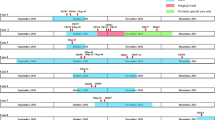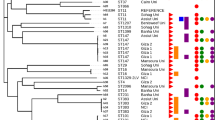Abstract
Identifying transmission route of antimicrobial-resistant pathogen is essential for appropriate infection control strategy in healthcare facilities. We report the utility of single-nucleotide variation analysis in tracing nosocomial transmission of antimicrobial-resistant pathogens by describing a pseudo-outbreak case of carbapenem-resistant Klebsiella pneumoniae. The present case highlights that infection control strategy should encompass pathological dissection rooms, neglected but potentially highly contaminated places in hospitals.
Similar content being viewed by others
Introduction
Klebsiella pneumoniae is a common pathogen in both nosocomial and community settings, causing various infections in humans. In recent years, treatment of severe infections with K. pneumoniae has been complicated because of the emergence of antimicrobial-resistant strains [1]. Carbapenem remains a possible therapeutic option; however, carbapenem-resistant K. pneumoniae (CRKP) has emerged as a global threat to public health [2, 3]. The drug resistance is horizontally transmitted among Enterobacteriaceae via plasmids, particularly posing a greater risk to hospitalized patients [4]. Infections with CRKP cause significantly higher mortality and prevention of the nosocomial infection is universally essential. For appropriate infection control strategies at healthcare facilities, it is vital to clarify their genetic characteristics and transmission routes. Conventional molecular approaches including gene amplifications and pulsed-field gel electrophoresis (PFGE) are usually of great help, but may occasionally not be enough to elucidate their virulence, resistance, and prevalence. In such cases, whole-genome sequencing possibly offers a further in-depth investigation of the bacterial characteristics and epidemiological relevance [5]. We herein report the utility of single-nucleotide variation (SNV) analysis in tracing the nosocomial transmission of CRKP.
Case presentation
In June 2015, an 81-year-old man was admitted to Osaka University Hospital for progressive heart failure symptoms (Case 1). Two weeks after hospitalization, the patient underwent a cardiac operation for mitral valve stenosis and was subsequently managed at an intensive care unit (ICU) because of ventilator-associated pneumonia. Three weeks after the surgery, multidrug-resistant CRKP was isolated from the patient’s throat (TUM15697) (Day 1). His respiratory condition deteriorated, and the CRKP was subsequently detected in aspirated sputum and blood (Day 14). Since such a highly resistant CRKP had never been isolated from the ICU, we performed a comprehensive screening of all admitted patients, using ChromID CARBA selective media (bioMérieux, Marcy l’Etoile, France). All patients tested were confirmed to be negative for CRKP on Day 16. Although the patient received combination therapy with amikacin and colistin, he developed persistent bacteremia with CRKP (TUM15700) and eventually died. The patient was transferred for an autopsy on Day 20.
Thirty-three days later, another patient in his seventies, who had undergone mitral valve replacement surgery for treatment of infective endocarditis caused by Enterococcus faecium, died in the ICU (Case 2). The patient underwent an autopsy at the same pathological dissection bed on Day 53. Although no pathological evidence of infective cardiac vegetation was apparent, CRKP with an antimicrobial susceptibility pattern similar to the isolate in Case 1 was detected from an autopsied cardiac valve (TUM15701). Nosocomial transmission was initially suspected, but CRKP had not been isolated from the patient in Case 2 during the clinical course, including the comprehensive screening. To clarify the resistance mechanism, the isolates were transferred to Toho University (Tokyo, Japan) for further molecular analysis.
Microbiological investigation
The identity and antimicrobial susceptibility of the bacteria were confirmed with the Phoenix 100 ID/AST system (Becton-Dickinson, Sparks, MD, USA). PFGE analysis of the isolated CRKP was conducted using a CHEF Mapper XA chiller system (Bio-Rad, Hercules, CA, USA). Chromosomal DNA was prepared in agarose blocks and digested with XbaI. The PFGE protocol was set as follows: 20 h at 14 °C, at 6 V/cm, a pulse angle of 120o, and pulse times ranging from 5.3 to 49.9 s. Phylogenetic tree of PFGE was inferred by BioNumerics software (Applied Maths, St-Martens-Latem, Belgium). To determine the whole-genome sequence, genomic and plasmid DNA were extracted from all isolated bacterial colonies, using a phenol–chloroform-based QIAquick PCR Purification Kit (Qiagen, Chatsworth, CA, USA). DNA libraries were prepared with a Nextera XT DNA Library Preparation Kit and MiSeq Reagent Kit v3 (Illumina Inc., San Diego, CA, USA), then sequenced with a MiSeq sequencer (Illumina) in 2 × 300-bp paired-end runs. The CLC Genomics Workbench software (CLC bio) was applied for assembly of the short reads. Based on the whole-genome sequencing data, multilocus sequence typing (MLST), capsular genotyping, and determination of antimicrobial resistance genes were performed using MLST 1.8, a wzc genotyping system, and the ResFinder web services (http://www.genomicepidemiology.org/: Center for Genomic Epidemiology, Lyngby, Denmark), respectively.
For a detailed investigation of the clonal relationship among all three isolates, SNV analysis was additionally performed using the whole-genome sequence (WGS) data. The core genome-based phylogenetic analysis was performed with RAxML (bootstrapping with 1000 repetitions), using short reads of the three CRKP isolates and nine available genomic sequences of K. pneumoniae. To extract SNVs, the short reads were aligned to K. pneumoniae strain MGH78578 (GenBank Accession No. NC_009648.1) as a reference sequence, using the bwa software (v.0.7.10) with the bwasw command [6]. All mutation sites were identified using the SAMtools (v.1.3) [7] and VarScan (v.2.3.7) [8] software with the default parameters.
All isolates were confirmed to be K. pneumoniae exhibiting a lack of susceptibility to beta-lactam antibiotics, including carbapenems, gentamicin, minocycline, levofloxacin, trimethoprim/sulfamethoxazole, and fosfomycin (Table 1). PFGE profiling of the three CRKP isolates presented a similar pattern, and the phylogenetic tree indicated all three isolates were originated from same clone (Fig. 1a). All three isolates were identified as clone ST225, which was not grouped with any of the clonal complexes examined. The capsular genotype of the isolates was identified as K3. Carbapenemase-encoding genes were not detected, but all the isolates possessed bla SHV-27 and bla CTX-M-14. TUM15700 and TUM15701 harbored bla CTX-M-8 as well. The isolates also possessed aac(3)-IId, sul1, dfrA1, tet(A and D), oqx(A and B), and qnrS1, which confer resistance to aminoglycosides, sulfonamide, trimethoprim, tetracycline, and fluoroquinolones, respectively. A nonsense mutation was detected in ompK36, C510A nucleotide substitution resulting in Q170X amino acid substitution in TUM15697, and C360A resulting Y120X in the other two. These nonsense mutations in ompK36 were expected to contribute to reduced susceptibility to carbapenems with the production of ESBLs. All the isolates were found to carry the IncI1 and IncFIB(K) plasmids.
Clonal analysis on isolated CRKP using PFGE and SNV. a PFGE analysis on isolated CRKP. Three CRKP isolates were analyzed with PFGE using XbaI-digestion. The phylogenetic tree was inferred by BioNumerics software. K. pneumoniae strains ATCC BAA-1705 and BAA-2473 were used as references. b Clonal transition model based on SNV acquired from whole-genome sequences of three CRKP isolates. Positions in the reference genome corresponding to SNV positions 1 to 5: 754,976; 2,227,092; 2,895,404; 2,895,552; 3,994,328. The SNVs at position 3 and 4 correspond to mutations at nucleotides 508 and 360 of ompK36, respectively. The isolation date of TUM15697 (the index isolate) from the Case 1 was set as Day 1
A whole-genome-based phylogenetic tree demonstrated that the three CRKP isolates formed a clonal cluster (Fig. 2). Of the 5,315,120 bp in the reference sequence, 4,967,706 bp (93.46%) were subjected to SNV analysis. Compared to that in the index isolate of TUM15697, four SNVs in TUM15701 and five SNVs in TUM15700 were identified. All the four SNVs (SNV positions 1–4) identified in TUM15701 were identical to those identified in TUM15700, in both the positions and nucleotide types (Fig. 1b). The 5th SNV position of TUM15701 remained the same as that of TUM15697.
Whole-genome-based midpoint-rooted phylogenetic tree. GenBank accession numbers of each standard strains are as follows; KpN01 (CP012987.1), ATCC_MGH_78578 (CP000647.1), KCTC_2242 (CP002910.1), CG43 (CP006648.1), ATCC43816_KPPR1 (CP009208.1), PMK1 (CP008929.1), KPNIH1 (CP008827.1), ATCC_BAA-2146 (CP006659.2), and Kp13 (CP003999.1). Core genomes were defined as chromosomal genes that the three clinical isolates commonly possess (at least 445,115 nucleotides). The scale bar denotes the number of nucleotide substitutions per site
Discussion
In the present case, we performed a WGS analysis to identify genes responsible for antimicrobial resistance. We additionally compared SNVs among the isolates to elucidate the possibility of nosocomial transmission.
The utility of SNV analysis in clarifying the epidemiology of antimicrobial-resistant bacteria has been well investigated for Staphylococcus aureus. In a methicillin-resistant S. aureus outbreak in a neonatal intensive care unit, the WGS method provided a better explanation of transmission pathways by separating a distinct cluster of outbreak isolates from others [9]. Additionally, the molecular approach demonstrated that patient-to-patient nosocomial transmission of S. aureus may be a rarer event than has been expected [10]. Mutation rates of S. aureus are estimated to range from 2.0 to 3.4 × 10−6 mutations per site per year, equating to 1 SNV difference every 5–10 weeks [10]. An SNV difference of >40 is considered roughly equivalent to 5-year evolution for S. aureus, on the basis of a population genetics approach [11, 12]. Similarly, the usefulness of the WGS technique in tracking nosocomial transmission of CRKP was recently reported [5]. The mutation rate of the K. pneumoniae pandemic clone ST258 has been reported to be approximately 1.0 × 10−6 substitutions per site per year [13]. However, the general mutation rates of clinical K. pneumoniae strains have yet to be clearly determined, and no outbreak investigation has applied the molecular approach to demonstrate the epidemiology of the pathogen.
There was only one SNV between the isolate from Case 1 (TUM15700) and that from Case 2 (TUM15701). Moreover, comparing the 5th SNV position, TUM15701 was presumed to be an ancestor of TUM15700; that is, TUM15697 chronologically changed to TUM15700 through the clinical course in Case 1, and an isolate with 4 SNVs transmitted to the patient from Case 2 along the way. A previous in vitro study corroborated that the mutation rate of the Escherichia coli genome is approximately one SNV per 17 days when subcultured each day under experimental conditions [14]. The time interval between the death of the two cases was 33 days. Provided that TUM15701 had transmitted to Case 2 during admission in the ICU and continued to proliferate in the patient’s body, the isolate should have had several SNVs at different positions. The lower number of SNVs in TUM15701 implied that the organism remained stable and did not generate additional mutations after more than 5 weeks. Human-to-human infection and indirect transmission via the environment may differ concerning bacterial proliferation rate. Since bacteria generally cannot grow well in the environment, we assume that this case could represent a pseudo-outbreak involving the pathological dissection room. The origin of the index isolate is unclear; however, the pathogen could have been carried in latently by the patient from Case 1, because we had never isolated such a multidrug-resistant K. pneumoniae in our facility.
In conclusion, SNV analysis can be a useful tool in tracing the nosocomial transmission of antimicrobial-resistant organisms, although it is not available routinely. The PFGE profiles alone indicated this case to be a nosocomial infection of CRKP; however, the WGS data finally corroborated it as a pseudo-outbreak involving the pathological dissection room.
References
Pitout JD, Nordmann P, Poirel L. Carbapenemase-producing Klebsiella pneumoniae, a key pathogen set for global nosocomial dominance. Antimicrob Agents Chemother. 2015;59:5873–84.
Gupta N, Limbago BM, Patel JB, Kallen AJ. Carbapenem-resistant Enterobacteriaceae: epidemiology and prevention. Clin Infect Dis. 2011;53:60–7.
Hauck C, Cober E, Richter SS, Perez F, Salata RA, Kalayjian RC, Watkins RR, Scalera NM, Doi Y, Kaye KS, Evans S, Fowler VG Jr, Bonomo RA, van Duin D, Antibacterial Resistance Leadership Group. Spectrum of excess mortality due to carbapenem-resistant Klebsiella pneumoniae infections. Clin Microbiol Infect. 2016;22:513–9.
Perez F, Van Duin D. Carbapenem-resistant Enterobacteriaceae: a menace to our most vulnerable patients. Cleve Clin J Med. 2013;80:225–33.
Onori R, Gaiarsa S, Comandatore F, Pongolini S, Brisse S, Colombo A, Cassani G, Marone P, Grossi P, Minoja G, Bandi C, Sassera D, Toniolo A. Tracking nosocomial Klebsiella pneumoniae infections and outbreaks by whole-genome analysis: small-scale italian scenario within a single hospital. J Clin Microbiol. 2015;53:2861–8.
Li H, Durbin R. Fast and accurate short read alignment with Burrows–Wheeler transform. Bioinformatics. 2009;25:1754–60.
Li H. A statistical framework for SNP calling, mutation discovery, association mapping and population genetical parameter estimation from sequencing data. Bioinformatics. 2011;27:2987–93.
Koboldt DC, Chen K, Wylie T, Larson DE, McLellan MD, Mardis ER, Weinstock GM, Wilson RK, Ding L. VarScan: variant detection in massively parallel sequencing of individual and pooled samples. Bioinformatics. 2009;25:2283–5.
Koser CU, Holden MT, Ellington MJ, Cartwright EJ, Brown NM, Ogilvy-Stuart AL, Hsu LY, Chewapreecha C, Croucher NJ, Harris SR, Sanders M, Enright MC, Dougan G, Bentley SD, Parkhill J, Fraser LJ, Betley JR, Schulz-Trieglaff OB, Smith GP, Peacock SJ. Rapid whole-genome sequencing for investigation of a neonatal MRSA outbreak. N Engl J Med. 2012;366:2267–75.
Price JR, Golubchik T, Cole K, Wilson DJ, Crook DW, Thwaites GE, Bowden R, Walker AS, Peto TE, Paul J, Llewelyn MJ. Whole-genome sequencing shows that patient-to-patient transmission rarely accounts for acquisition of Staphylococcus aureus in an intensive care unit. Clin Infect Dis. 2014;58:609–18.
Price JR, Cole K, Bexley A, Kostiou V, Eyre DW, Golubchik T, Wilson DJ, Crook DW, Walker AS, Peto TE, Llewelyn MJ, Paul J; Modernising Medical Microbiology informatics group. Transmission of Staphylococcus aureus between health-care workers, the environment, and patients in an intensive care unit: a longitudinal cohort study based on whole-genome sequencing. Lancet Infect Dis. 2017;17:207–14.
Golubchik T, Batty EM, Miller RR, Farr H, Young BC, Larner-Svensson H, Fung R, Godwin H, Knox K, Votintseva A, Everitt RG, Street T, Cule M, Ip CL, Didelot X, Peto TE, Harding RM, Wilson DJ, Crook DW, Bowden R. Within-host evolution of Staphylococcus aureus during asymptomatic carriage. PLoS ONE. 2013;8:e61319.
Bowers JR, Kitchel B, Driebe EM, MacCannell DR, Roe C, Lemmer D, de Man T, Rasheed JK, Engelthaler DM, Keim P, Limbago BM. Genomic analysis of the emergence and rapid global dissemination of the clonal group 258 Klebsiella pneumoniae pandemic. PLoS ONE. 2015;10:e0133727.
Barrick JE, Yu DS, Yoon SH, Jeong H, Oh TK, Schneider D, Lenski RE, Kim JF. Genome evolution and adaptation in a long-term experiment with Escherichia coli. Nature. 2009;461:1243–7.
Author information
Authors and Affiliations
Corresponding author
Ethics declarations
Conflict of interest
All authors report no conflicts of interest relevant to this article.
Rights and permissions
About this article
Cite this article
Hagiya, H., Aoki, K., Akeda, Y. et al. Nosocomial transmission of carbapenem-resistant Klebsiella pneumoniae elucidated by single-nucleotide variation analysis: a case investigation. Infection 45, 221–225 (2017). https://doi.org/10.1007/s15010-017-0986-3
Received:
Accepted:
Published:
Issue Date:
DOI: https://doi.org/10.1007/s15010-017-0986-3






